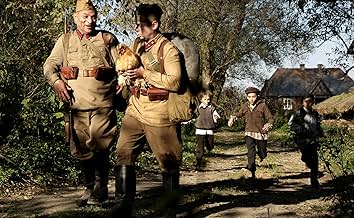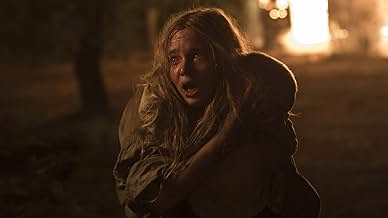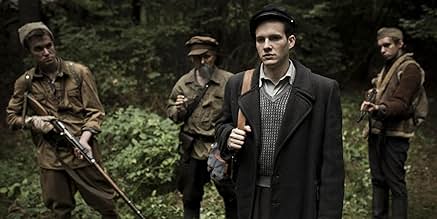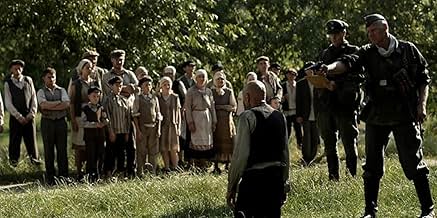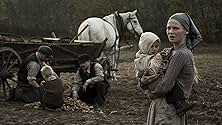Wolyn
- 2016
- 2h 30m
ÉVALUATION IMDb
7,6/10
7,2 k
MA NOTE
Ajouter une intrigue dans votre langueDespite being in love with a Ukrainian boy from the same village, Polish girl named Zosia is forced into marrying a wealthy widower. Soon World War II begins and ethnic tensions arise. Amids... Tout lireDespite being in love with a Ukrainian boy from the same village, Polish girl named Zosia is forced into marrying a wealthy widower. Soon World War II begins and ethnic tensions arise. Amidst the war chaos Zosia tries to survive.Despite being in love with a Ukrainian boy from the same village, Polish girl named Zosia is forced into marrying a wealthy widower. Soon World War II begins and ethnic tensions arise. Amidst the war chaos Zosia tries to survive.
- Director
- Writer
- Stars
- Prix
- 17 victoires et 7 nominations au total
Avis en vedette
A very powerful movie. The acting and cinematography were excellent. Michalina Labacz especially shines in her lead role. Although the movie is two and a half hours long the pacing keeps your attention throughout.
As many have noted, this film has a great deal of graphic violence. Not only quick killings, but also gruesome torture. It is a testament to the director that for the most part he does not linger on such scenes. For me, it was not always the case, and there were several times that I had to look away.
The characters are numerous and of many nationalities and religions, but the movie rarely casts anyone as black and white caricatures. No side comes out as pure and innocent, or completely evil. Along with the massacres by Ukrainians, we also see the arrogance of Polish upper class village residents, and even protection by some German soldiers.
The swirl of death on all sides and by all sides leaves one numb by the end, but it important story. In addition to telling the story of an often overlooked part of East European history, it also is a more general warning of how easily the dark side of humanity can come forward in times of adversity.
As many have noted, this film has a great deal of graphic violence. Not only quick killings, but also gruesome torture. It is a testament to the director that for the most part he does not linger on such scenes. For me, it was not always the case, and there were several times that I had to look away.
The characters are numerous and of many nationalities and religions, but the movie rarely casts anyone as black and white caricatures. No side comes out as pure and innocent, or completely evil. Along with the massacres by Ukrainians, we also see the arrogance of Polish upper class village residents, and even protection by some German soldiers.
The swirl of death on all sides and by all sides leaves one numb by the end, but it important story. In addition to telling the story of an often overlooked part of East European history, it also is a more general warning of how easily the dark side of humanity can come forward in times of adversity.
The eastern limits of Poland were set after WWI along the Curzon line, roughly today's boundary. After Poland's victory over the Bolsheviks in the Russian Civil War, the boundary was shifted East. Some regions of the former Austro-Hungarian Empire such as Volhyn (the original title of this movie) and Eastern Galicia became de facto Polish, although Poles were a minority; for Volhyn the percentages were 70%, 16% and 10% for Ukrainians, Poles and Jews.
The film begins with a village wedding in Volyn shortly before the outbreak of WWII. The various ethnic groups are seen living in wary mistrust of each other. From conversations we learn that Ukrainians resent their heavy handed treatment by Polish authorities. Use of the Ukrainian language is forbidden or discouraged. Ukrainian schools are being closed. So are Orthodox and Greek Catholic churches, some demolished, others converted to Catholic churches.
In September 1939 the Soviets occupy Volhyn and Eastern Galicia in answer to Hitler's invasion of Poland. In June 1941 the region is overrun and occupied by Nazi troops on their way to invade the Soviet Union. Initially, some Ukrainians welcome the Germans in the belief they would support a free, independent Ukraine, but this hope is soon dashed. Some extreme right wing diehards such as the OUN = Organization of Ukrainian Nationalists and its paramilitary branch the UPA = Ukrainian Insurgent Army ally themselves with the occupiers and carry out a bloody campaign of ethnic cleansing against Polish and other minorities. This is the backdrop for the story, which centers on the the vicissitudes of bride Hela and sister Zosia during the war.
This film does everything well, including an even handed treatment of controversial history. It is spoken in Polish, Ukrainian and Russian and the subtitles do a good job of identifying each language. It is available in the streaming services under the title Hatred, the name of the novel on which it is based.
The film begins with a village wedding in Volyn shortly before the outbreak of WWII. The various ethnic groups are seen living in wary mistrust of each other. From conversations we learn that Ukrainians resent their heavy handed treatment by Polish authorities. Use of the Ukrainian language is forbidden or discouraged. Ukrainian schools are being closed. So are Orthodox and Greek Catholic churches, some demolished, others converted to Catholic churches.
In September 1939 the Soviets occupy Volhyn and Eastern Galicia in answer to Hitler's invasion of Poland. In June 1941 the region is overrun and occupied by Nazi troops on their way to invade the Soviet Union. Initially, some Ukrainians welcome the Germans in the belief they would support a free, independent Ukraine, but this hope is soon dashed. Some extreme right wing diehards such as the OUN = Organization of Ukrainian Nationalists and its paramilitary branch the UPA = Ukrainian Insurgent Army ally themselves with the occupiers and carry out a bloody campaign of ethnic cleansing against Polish and other minorities. This is the backdrop for the story, which centers on the the vicissitudes of bride Hela and sister Zosia during the war.
This film does everything well, including an even handed treatment of controversial history. It is spoken in Polish, Ukrainian and Russian and the subtitles do a good job of identifying each language. It is available in the streaming services under the title Hatred, the name of the novel on which it is based.
This is actually sad that ukrainian people started forgetting their own history. We have to remember our own history, no matter if it's good history or bad.
...but not really known in the rest of Europe and world. Important film, nobody every told this story in the film world. Very graphic though - as usual with the director Smarzowski. Most of his films are made with this idea of starting with light themes, here it's a wedding and then with time becoming more and more dark and gloomy. This one will leave you speechless. I strongly recommend this one, but viewer discretion is strongly advised.
I have seen my fair share of horror and gore movies but the most harrowing of horror films are those based on real events and the worst horrors are the ones being depicted not by imaginary monsters but by human beings.
Fair warning this one is a tough watch even if you're used to such films, it does not shy away from the violence that was committed during this time so be prepared to see men, woman and small children (even babies) being brutally murdered in some of the worst ways possible.
Overall this was a well made movie and I enjoyed it as a film but was completely shook up by it's content, not being a European myself (though familiar with these events) I still found it difficult at times to tell who was who as it involves Poles, Ukrainians, Jews, Germans and Russians including all the partisan groups and even mixtures of the above so one must pay close attention to follow along.
If you're looking for a good anti-war film this is it, after watching you will be utterly disgusted with what took place and if you're not then you're not human.
Fair warning this one is a tough watch even if you're used to such films, it does not shy away from the violence that was committed during this time so be prepared to see men, woman and small children (even babies) being brutally murdered in some of the worst ways possible.
Overall this was a well made movie and I enjoyed it as a film but was completely shook up by it's content, not being a European myself (though familiar with these events) I still found it difficult at times to tell who was who as it involves Poles, Ukrainians, Jews, Germans and Russians including all the partisan groups and even mixtures of the above so one must pay close attention to follow along.
If you're looking for a good anti-war film this is it, after watching you will be utterly disgusted with what took place and if you're not then you're not human.
Le saviez-vous
- AnecdotesBefore ending credits: "In the period of 1943-45, an estimated 80 to 10 thousand Poles and 10 to 15 thousand Ukrainians had fallen victim to Ukrainian nationalists' attacks and Polish retaliations in the Eastern borderlands."
Meilleurs choix
Connectez-vous pour évaluer et surveiller les recommandations personnalisées
- How long is Hatred?Propulsé par Alexa
Détails
- Date de sortie
- Pays d’origine
- Site officiel
- Langues
- Aussi connu sous le nom de
- Hatred
- Lieux de tournage
- sociétés de production
- Consultez plus de crédits d'entreprise sur IMDbPro
Box-office
- Budget
- 10 000 000 PLN (estimation)
- Brut – à l'échelle mondiale
- 6 960 645 $ US
Contribuer à cette page
Suggérer une modification ou ajouter du contenu manquant


